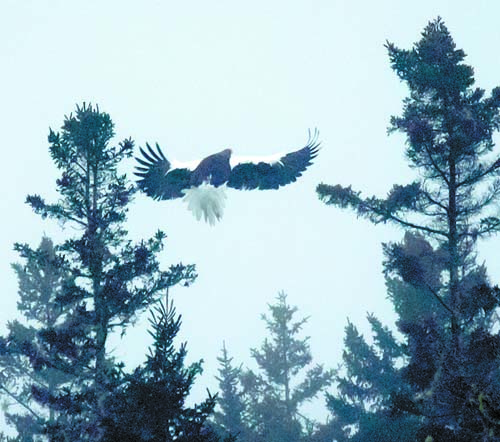Earth Notes: A new bird for a New Year

By Mary Jewett
Guest Columnist
My last Earth Notes column, back in October, explored the difference between birdwatching and “twitching.” In the spring, my birdwatching hobby sees me up at dawn, traveling locally to see my favorite migrants on their northward journey. I also spent a very pleasant day on Dec. 28 participating in the Christmas Bird Count, which Jean Preis has written about in this issue.
Twitching is a much more adventurous activity, and is likely to get you called a bird nerd for traveling all over kingdom come to see a particular bird. As an avid birder, it isn’t easy to see a new bird species in Maine in the winter. If you have been at it for a few years, it is likely you have seen most of the local species, and those rarely change. However, every once in a while, something new comes along that shakes everything up.
I am talking, of course, about the crazy rare Steller’s Sea Eagle, the bird of the century. This amazing, terribly lost, bird has been wandering around North America for close to a year, first showing up in Alaska (which makes sense) and then traveling east across Canada (which doesn’t make sense). If you haven’t heard about this yet, there are about a dozen articles online, and a recent one in the Portland Press Herald. I won’t retell all the stories, but I will share my own twitching experience.
To say this bird is rare would be an understatement. It is most commonly found on the Kamchatka Peninsula in far Eastern Russia. There are an estimated 4,000 individuals living and they are considered a vulnerable species. I first heard about the sea eagle when it was spotted along the Taunton River in Massachusetts the week before Christmas. I seriously considered going down, but by the time I got up the gumption it had moved on. Every birder in Maine then made their Christmas wish, that it would come here next, and we all went about our business.
And then, on Dec. 30, the sea eagle was spotted by a woman in Georgetown, Maine, and the news spread like wildfire. On New Year’s Eve day, hundreds of birders from all over New England had converged upon the small coastal town, and no one was disappointed. I took a terrible chance and didn’t cancel my plans for Friday, deciding to head up Saturday morning instead. For most of the day on Friday, I oscillated between being comfortable with my decision to thinking I was an absolute fool for not jumping on the bandwagon.
I awoke early on Saturday and headed up to Georgetown as soon as possible. I knew the bird wouldn’t be spotted before sunrise, but I also knew that parking would become a problem the longer I waited. It was a perfectly horrible day for seeing a new “life bird.” The sun was not shining and all the clouds were in the sky. A light drizzle had started and the fog was so thick on the drive in that I couldn’t see 50 feet in front of my car. I knew the bird would not be seen if the fog didn’t clear, and I was prepared to wait all day if necessary.
There were still a few spots in the public lot when I arrived, rolling in at the same time as two carloads of birders from Connecticut. As I was walking from the lot, I passed two women who were leaving. They sadly (for them), and accurately, predicted that I would see the bird since they had to leave for work. I found a spot amongst the dozens of others and began my own scan of the water. From our vantage point, in the parking lot of a lobster company, we could see a handful of islands, with nice tall pines perfect for a large bird to perch in. About 20 minutes after I arrived, it was spotted, and it began a slow migration from island to island, causing a frenzy of activity every time it moved. The Steller’s Sea Eagle has an eight-foot wingspan and can weigh up to 20 pounds. If it wasn’t such a massive bird there is little chance anyone would have seen it.
Lastly, I’d like to address the photo I included with my article. I don’t even know if the editor will allow it (we did), given the poor quality, but I have submitted it anyway. This is the kind of photo that I normally wouldn’t share, it is grainy, and slightly blurry, which isn’t surprising, given the fact that the Steller’s Sea Eagle was over 500 feet away through the fog. Heavily cropped and edited, it is my new favorite photo, and I’ve been showing it off like it’s a new baby.
I often feel sadness when watching birds that are so far off track. A few years ago, a Great Black Hawk showed up in Portland and, sadly died due to the cold. Fortunately, the Steller’s Sea Eagle is well adapted to cold, marine environments and, after several months of travel, they seem none the worse for being away from home. It also seems completely unfazed by the attention it is receiving from all of us bird nerds.
Mary Jewett is an Educator and CBI Director at Lakes Environmental Association.

